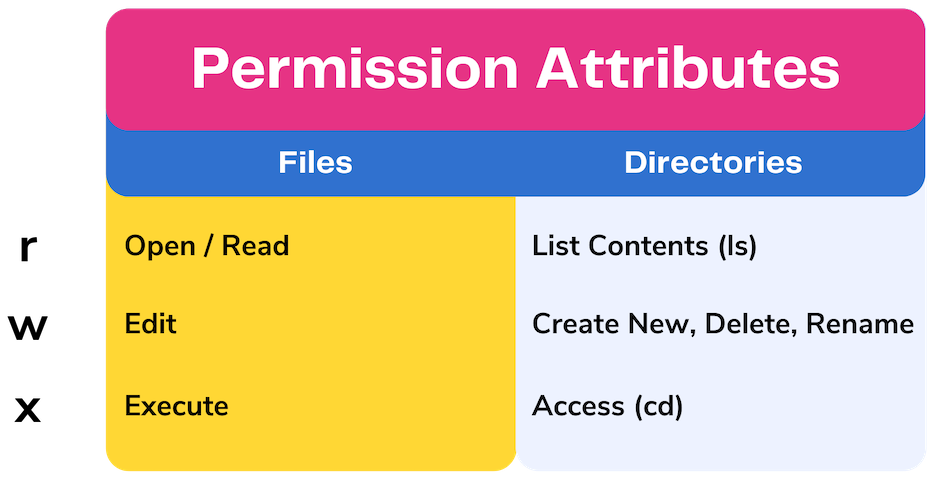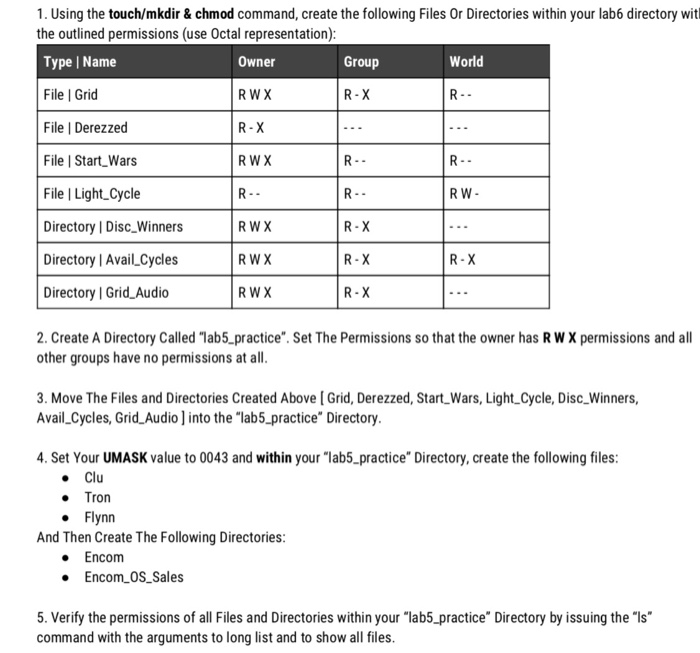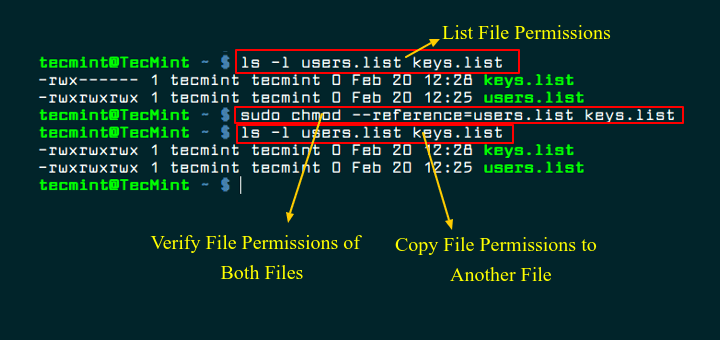[最も共有された! √] chmod octal 244893-Chmod octal notation
Chmod changes the file mode bits of each given file according to mode, which can be either a symbolic representation of changes to make, or an octal number representing theFile access, meaning permissions, can be represented alphanumerically (using symbols like r for read, w for write and x for execute) or using octal numeric values (755 for example) Chmod options You can extend chmod permissions with options 6 umask affects chmod;

Using Braille To Memorize Mathematical Formulas General Memory Chat Art Of Memory Forum
Chmod octal notation
Chmod octal notation-What is the chmod command?Chmod command is used to change permissions of a given file according to a certain mode which might be a set of octal characters or a set of alphabetical characters The output of this command will look something like this The string rwxrxrx represents the permissions of




Linux File Permission Javatpoint
7 Using numeric 022style octal permissions; The following command will accomplish this chmod 664 *page This sets the permissions we require for the user, group members, and others to what we require The users and group members have their permissions reset to what they already were, and the others have the read permission restored ls lChmod is quite simple to use while using octal notation The structure of the command is simply chmod < octal permission you wish to set > < file or directory > chmod usage example
This tutorial explains chmod command symbolic notation (r, w, x, a) and octal notation (0, 1, 2, 4) in detail with chmod command arguments and options Learn how chmod command is used to manage Linux permission levels (user, group and other) and types (read, write and execute) step by step with practical examples The chmod command in various UNIX flavors such as Solaris, Linux, Mac OSX, and others, allows the access controls of a file or directory to be set This techrecipe describes the more complex octal chmod syntax See the techrecipe Set UNIX file access permissions with chmod for the basics of file permissions and chmod ThisChmod changes the file mode bits of each given file according to mode, which can be either a symbolic representation of changes to make, or an octal number representing the bit pattern for the new mode bits To learn more use our calculator and read the references below at the bottom of this page
Below are some options of the chmod command FILE Replace FILE with the file you want to change its permissions MODE, OCTALMODE Replace the MODE (rwx) or OCTALMODE (777) with value to change the permission to c, –changes Use the c or –changes option to show verbose but report only when a change is madeThe chmod system call cannot change their permissionsChmod OCTALMODE FILENAME where OCTALMODE is the octal form of the permissions For example, to set the permissions of filename to rwrryou could run the command chmod 644 filename or to change permissions to rwxrwxrwx you could use the




If The Octal Value Of The Permissions On A File Is Chegg Com




Linux Chmod Command Linuxfordevices
Using octal value & position Sets the permission for owner, group and others with octal values , 4 for read , 2 for write , 1 for execute and any sum of these number to get cumulative permissions chmod syntax using octal modeChmod 775 file_name chmod ugrwx,o=rx file_name Hope this helps new users to understand and get knowledge about Symbolic Notation & using Octal number for chmod you can download pdf version of linuxcommandline book from sourceforgeprojectChmod calculator generates command in number format for file and directory permissions in Unix and Linux If you are working on Unix, Linux server then permissions are a very important and difficult task Our chmod calculator generates file permissions for owner, group, and the public in number (744) and symbolic (rwxrr) notation formats




How To Change Existing Permission Numerically




Ppt Information Systems Security Powerpoint Presentation Free Download Id
Chmod In Unix and Unixlike operating systems, chmod is the command and system call used to change the access permissions of file system objects ( files and directories) sometimes known as modes It is also used to change special mode flags such as setuid and setgid flags and a 'sticky' bit Octal notation is a numerical system for modifying the permissions on Linux, Mac and other Unix like file systems Each octal permission can be represented by 3 or 4 numbers; The command chmod changes the file mode bits of each given file according to mode, which can be either a symbolic representation of changes to make, or an octal number representing the bit pattern for the new mode bits chmod never changes the permissions of symbolic links;




When To Use Chmod Vs Chown Cbt Nuggets




Solved 3 Use Chmod With Octal Number To Forbid All Chegg Com
What is chmod command in Linux The "chmod" is an acronym for "change mode" It modifies the access of your system directories, files, and scripts The "chmod" command has specific modes that determine the permission for modification These modes are represented by numerical form (letters) or symbolic form (octal numbers) When youYou can use the chmod command to set permissions in either of two modes Absolute Mode Use numbers to represent file permissions (the method most commonly used to set permissions) When you change permissions by using the absolute mode, represent permissions for each triplet by an octal mode numberBinary executables with the setgid bit (chmod gs path) can be executed with the privileges of the file's group A useful property is to set the setgid bit on a directory so that all files and directories newly created within it inherit the group from that directory In octal, the setgid bit is represented by 00 eg "chmod 2755 path"




Understanding Linux Permissions And Chmod Usage




File System Security In Unix Annie Calpe Overview
Chmod Calculator is a free utility to calculate the numeric (octal) or symbolic value for a set of file or folder permissions in Linux servers How to use Check the desired boxes or directly enter a valid numeric value (eg 777 ) or symbolic notation (eg rwxrwxrwx ) to see its value in other formats The chmod command specifies readwriteexecute permissions for the user, and readexecute permissions for group and otherchmod Octal Digit Binary Representation (rwx) Chmod supports two different systems the symbolic notation using letters and allocation of data rights through digitbased octal codes As previously mentioned, changes to access rights can only be made by the file owner or root user




Special File Permissions In Linux Start With Linux Mannu Linux




Command Line Understanding Chmod Symbolic Notation And Use Of Octal Ask Ubuntu
The chmod ("change mode") command is used to change the permission flags on existing files It can be applied recursively using the R option It can be invoked with either octal values representing the permission flags, or with symbolic representations of the flags chmod og= filename Copy Give read, write and execute permission to the file's owner, read permissions to the file's group and no permissions to all other users chmod u=rwx,g=r,o= filename Copy Add the file's owner permissions to the permissions that the members of the file's group have chmod gu filename Copy The same permission settings can be defined using the octal format with the command chmod 644 testtxt Define File Permission in Octal/Numeric Mode Note If you need a more indepth guide on how to use Chmod In Linux to change file permissions recursively, read our Chmod Recursive guide




Get To See The Permissions Of A File In Octal Format Linux Addicts



Everything About Chmod Command In Linux Hackerearth
# chmod 755 testtxt # ls l testtxtrwxrxrx 1 root root Jun 17 11 test2txt Changing permissions on a directory chmod OCTALMODE DIR – This example shows how us changing the permissions on a directory named php # chmod 755 php mode of `php' changed to 0777 (rwxrwxrwx) # ls l drwxrwxrwx 3 root root 40K php/From the (english) man page for chmod (debian jessy) (Highlight by me) A numeric mode is from one to four octal digits (07), derived by adding up the bits with values 4, 2, and 1 Omitted digits are assumed to be leading zerosBasic permissions in linux permission classes chmod command with octal & symbolic representation Chandan Sen 4 mins ago 0 0 Hello guys , this video is about understanding basic permissions in linux that includes read ,write and execute access modes I




Linux File Permission Javatpoint



Media Management Permissions Error Must Contain A Valid Unix Permissions Octal Issue 3869 Sonarr Sonarr Github
Table 41 Changing Directory and File Access Permissions (continued) chmod command (octal or letters) Original Permission Permission Description chmod gor drwxdrwxrrAdding read permission to a directory may not give desired results Without execute on, others can't view the contents of any files in that directory chmod 0777 Chmod table 3243Chmod table permissions In Unix andChmod The chmod command can be used with either a textbased argument or 3 octal digits (see note 1 ) to change the permissions on a file An example of the textbased command to add "read" permission for group members and others to a file named foo is Each permission can be thought of as a single binary digit that is " 1 "if the permission1 umask blocks default permissions Index When a process creates a new file system object, such as a file or directory, the permissions of that new object are determined by




Freebsd Find The Chmod Numerical Value For A File Or Directory Nixcraft




Linux Users And Groups Linode
The octal notation would be calculated as follows Calculation rwx = 421 = 7 rx = 4 = 6 r = 4 = 6 Ultimately, this would give us 766 as the corresponding octal notation to rwxrwrw Changing file permissions with chmod command using octal notation To change file permissions of a file use the syntax below Converting chmod permissions¶ Chmod changes the permissions of a given file/ directory according a to a rights description in a certain mode A mode can be octal (description with numbers) or symbolic (description with letters) leading 0 means this is octal constant, not the decimal one and you need an octal to change file mode permissions are a bit mask, for example, rwxrwxis in binary, and it's very easy to group bits by 3 to convert to the octal, than calculate the decimal representation 0644 (octal) is in binary (i've added dots for readability), or, as you may calculate,




Learning The Shell Lesson 9 Permissions




Unix Permissions The Easy Way Index Of All Chmod Permutations By Semi Koen Towards Data Science
Where each of these numbers is an "octal", meaning they range from 07 Click to see full answer People also ask, what is the octal value for the permission?




Your Own Linux Chmod Basics Of Files Directories Permissions And Use Of Chmod




Cit 500 It Fundamentals Users And Filesystems 1




Advance File Permissions In Linux Geeksforgeeks




Agenda The Linux File System Chapter 4 In




I Made This Chmod Cheat Sheet And Thought It Might Be Useful Linux4noobs




Command Line Understanding Chmod Symbolic Notation And Use Of Octal Ask Ubuntu



I Made This Chmod Cheat Sheet And Thought It Might Be Useful Linux4noobs




Understanding Linux Permissions And Chmod Usage




Octal And Numerical Permissions Using Chmod Command In Linux Linux Tutorial Youtube



1




Pin By Dr Stefan Gruenwald On Cheatsheets Computer Science Programming Iphone Information Learn Javascript




Linux Chmod Command




How To Change Permissions In Linux




Permissions In Linux Geeksforgeeks




Changing Permissions Via Chmod Linux Geek Tech Stuff




Unix Permissions




Codepen Chmod Numeric To Symbolic Calculator




Command Line Understanding Chmod Symbolic Notation And Use Of Octal Ask Ubuntu




Advance File Permissions In Linux Geeksforgeeks




Advance File Permissions In Linux Geeksforgeeks




Command Line Understanding Chmod Symbolic Notation And Use Of Octal Ask Ubuntu



How To Use Chmod




9 Quick Chmod Command Examples In Linux




Csci The Unix System The File System Ppt Video Online Download




Unix Permissions The Easy Way Index Of All Chmod Permutations By Semi Koen Towards Data Science




Translate Rwx Permissions Into Octal Format In Linux




Changing Permissions Via Chmod Linux Geek Tech Stuff




How To Display File Permissions In Octal Format In Linux Kompjuteras




Chmod Cheatsheet Linux




Understanding Linux Permissions And Chmod Usage



Understanding Linux File Permissions With Chmod Umask Chown And Chgrp Liquidon Net




Solved 1 Using The Touch Mkdir Chmod Command Create The Chegg Com




How To Get Octal File Permissions On Linux Unix Command Line Nixcraft




Linux File Permissions Tutorial How To View And Change Permission




How To Display File Permissions In Octal Format In Linux Kompjuteras




Chapter 4 Security And File Permission Users And




Chmod Options Permissions Files Linux Pocket Guide Book




Linuxvoice Still Using Octal With Chmod Here S Our Guide To File Permissions And Access Controls T Co Dhfcsds54a T Co Cwwekypyr9




How To Get Octal File Permissions From Command Line In Mac Os Osxdaily




What Is Ftp Chmod Chmod Change Mode Impress Org




Is There A Web Based Converter Between Rwx And The Octal Version Unix Linux Stack Exchange



What Does Chmod 755 Do Quora



Media Management Permissions Error Must Contain A Valid Unix Permissions Octal Issue 3869 Sonarr Sonarr Github




Change File Permissions Easily With Online Chmod Calculator By Chmodcalcu Issuu




File Permissions In Linux Can Be Set Using A 3 Digit Chegg Com




A Unix And Linux Permissions Primer Daniel Miessler




How To Use Chmod Command In Linux Explained With Examples




Linux Users And Groups Linode



Github Jhuesser Chmod Calculator A Small Chmod Calculator For Windows



1




Workbook 4 File Ownerships And Permissions Ppt Video Online Download




How To Use Chmod Command In Linux Explained With Examples




File Permissions Mode 0777 Vs 777 Digital Fortress



Common Bash Commands




How To Copy File Permissions And Ownership To Another File In Linux




Using Braille To Memorize Mathematical Formulas General Memory Chat Art Of Memory Forum




Permissions In Linux Geeksforgeeks




Solved Part 3 Permissions For Files Follow The Instructions Chegg Com




How To Use Chmod Command In Linux Explained With Examples



Understanding File Permissions 2buntu




How To Display File Permissions In Octal Format In Linux Kompjuteras




M03t3 2 Intro To Linux Chmod Octal Permissions Youtube




What Is The Meaning Of Chmod 755 And How To Execute And Verify It




Gettin Sticky With It Linux Journal




An Introduction To Linux File Permissions Boolean World




Solved 3 Use Chmod With Octal Number To Forbid All Chegg Com




Linux Operating System Then Go To Terminal And Chegg Com




Explained How To Use Chmod Command Complete Guide Youtube



Linux Chmod Tips




Command Line Understanding Chmod Symbolic Notation And Use Of Octal Ask Ubuntu



1



Chmod




Chmod Octal Mode タコトメウォール




Your Own Linux Chmod Basics Of Files Directories Permissions And Use Of Chmod




Understanding Linux Permissions And Chmod Usage




Linux And Unix Chmod Command Knowledge Hub




Unix File Permissions Computer Science




Linux Free Course Module 3 Chapter 1 File Management File Attributes Permissions Pythonbaba Com




Agenda Shortcuts Converting Among Numbering Systems Binary To Hex Hex To Binary Binary To Octal Octal To Binary Signed And Unsigned Binary Numbers Ppt Download




Linux Permissions Pluralsight



I Made This Chmod Cheat Sheet And Thought It Might Be Useful Linux4noobs




Understanding Linux Permissions And Chmod Usage




Chmod Cheat Sheet Dan Flood




Whatever You Knew About Chmod Is Wrong Alien Coders




Chmod Ultimate Octal Helper By Thierry Lubrez




Modify File Permissions With Chmod Microhost Cloud
コメント
コメントを投稿